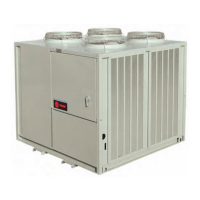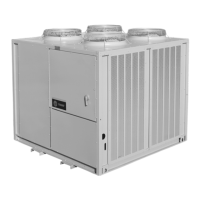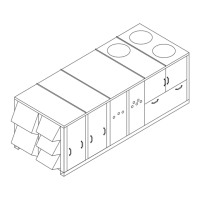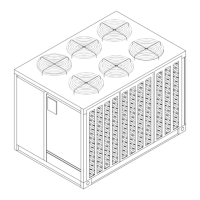46
CAUJ-SVX01E-EN
To break the vacuum, close valves A, B, & C and
connect a refrigerant cylinder to the charging port on
the manifold. Purge the air from the hose. Raise the
standing vacuum pressure in the system to “zero” (0
psig) gauge pressure. Repeat this process two or three
times during evacuation.
NNoottee:: It is unlawful to release refrigerant into the
atmosphere. When service procedures require
working with refrigerants, the service technician
must comply with all Federal, State, and local
laws. See the General Service Bulletin MSCU-SB-
1 (latest edition).
Standing Vacuum Test
Once 300 microns or less is obtained, close Valve A and
leave valves B and C open. This will allow the vacuum
gauge to read the actual system pressure. Let the
system equalize for approximately 15 minutes. This is
referred to as a “standing vacuum test” where, time
versus pressure rise. The maximum allowable rise over
a 15 minute period is 200 microns. If the pressure rise is
greater than 200 microns but levels off to a constant
value, excessive moisture is present. If the pressure
steadily continues to rise, a leak is indicated. Figure 27,
p. 46 illustrates three possible results of the “standing
vacuum test”.
If a leak is encounter, repair the system and repeat the
evacuation process until the recommended vacuum is
obtained. Once the system has been evacuated, break
the vacuum with refrigerant, and complete the
remaining “Pre-Start Procedures” before starting the
unit.
Figure 26. Typical vacuum pump hookup
Manifold
Valve C
Valve B
Vacuum Ga uge
Valve A
Vacuum
Pump
To Syste m
High Side
To Syste m
Low Side
Figure 27. Evacuation time vs. pressure rise
200
400
600
800
1000
1200
1400
1600
TIME IN MINUTES
PRESSURE IN MICRONS
Continuously increas ing press ure
indica tes the pres ence of lea ks ,
m oisture or bot h.
Initial evacuation pres s ure
State of equilibrium indicates the
true amount of moisture left in
the system. It indicates that no
leaks are present and the
system is properly ev acuated
Sta te of e quilibrium indica te s
the true a m ount of m oisture
left in th e system . It indica te s
tha t n o leaks are pre sent, but
furth e r e vacuation is re qu ired.
-10
0 1 0 20 30 4 0 50 60 70 80 9 0
Voltage Imbalance
Excessive three phase voltage imbalance between
phases will cause motors to overheat and eventually
fail. The maximum allowable voltage imbalance is 2%.
Measure and record the voltage between phases 1, 2,
and 3 and calculate the amount of imbalance as
follows:
% Voltage Imbalance = 100 x [(AV - VD)/(AV)] where:
• AV (Average Voltage) = (Volt 1 + Volt 2 + Volt 3)/3
• V1, V2, V3 = Line Voltage Readings
PPrree--SSttaarrtt

